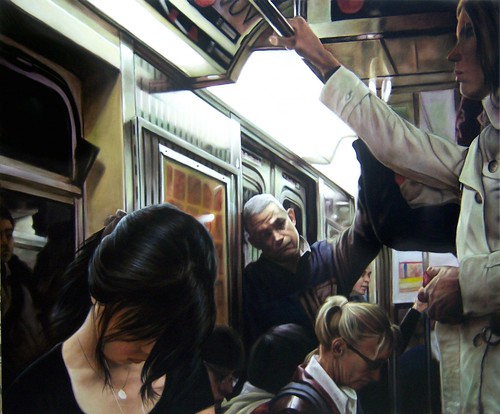[Oil on canvas, 25 x 26 inches]
Tuesday, August 31, 2010
Palmer Hayden - The Janitor Who Paints [c.1930]

[Oil on canvas, 99.3 x 83.6 cm]
Monday, August 30, 2010
Jan Steen - Two Kinds Of Games [c.1636-79]
[Oil on canvas, 63 x 69.50 cm]
Sunday, August 29, 2010
Juan Carlos Martinez - Lidia

See: http://www.juanmartinez.com/
Saturday, August 28, 2010
Jean-Leon Gérome - Slave Market in Ancient Rome [c.1884]
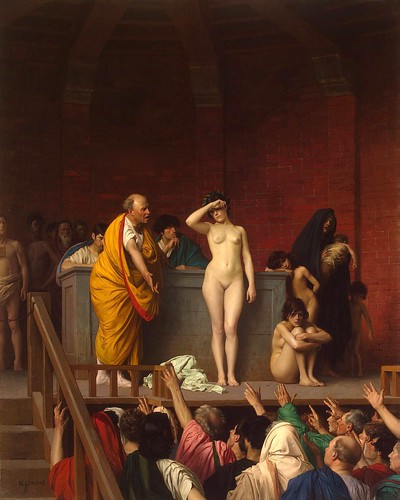
At the centre of a high dais are two naked women; the slave dealer is displaying them to the crowd, showing off the goods he has for sale. The smooth painterly style, the precise linear drawing and sculptural modelling of forms were the traditional academic principles taught at the Ecole des Beaux-Arts, where Gérome was on the staff for over 40 years.
Friday, August 27, 2010
Daniel Gerhartz - In Her Care
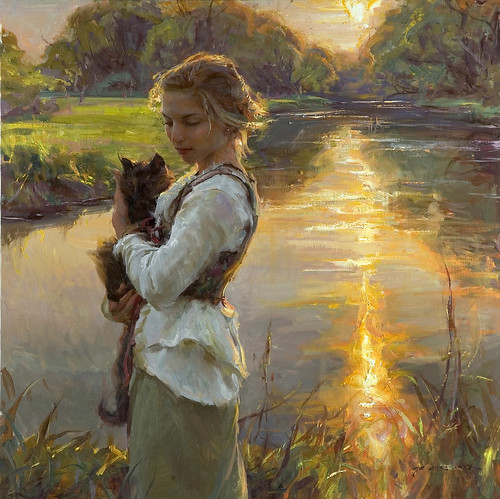
Gerhartz has a particular interest and appreciation for modern Russian art and the sumptuous canvases of the painters Nicolai Fechin, Isaac Levitan and Ilya Repin. As Dan says, their paintings are "completely loose yet deliberate and faithful, not at all flashy."
[Oil on canvas, 40 x 40 inches]
Albert Edelfelt - Good Friends, Portrait of the Artists Sister Bertha Edelfelt [1881]
[Oil on panel, 41 x 31.5 cm]
Thursday, August 26, 2010
Hans Holbien the Younger - The Ambassadors [1533]

[Oil on oak, 207 x 209.5 cm]
Lucien Freud - Girl with a White Dog [1951-52]
Wednesday, August 25, 2010
Caspar David Friedrich - The Stages of Life [c.1835]
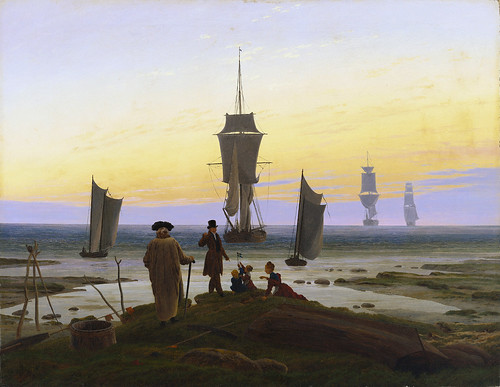
Paul Delaroche - The Execution of Lady Jane Grey [1834]

Tuesday, August 24, 2010
Henri Jules Jean Geoffroy - Study of an Old Woman’s Head
Monday, August 23, 2010
Joseph Solman - Dick and Betsy

Sunday, August 22, 2010
Claire Bridge - Ignorance Isn't Bliss [2009]

See: http://www.clairebusuttilbridge.com/index.htm
[Oil on Belgian linen, 123.4 x 85.7 cm]
Saturday, August 21, 2010
Rembrandt - Portrait of Maria Trip [1639]

Friday, August 20, 2010
Rembrandt - Portrait of Johannes Wtenbogaert [1633]

[Oil on canvas, 130 x 103 cm]
Thursday, August 19, 2010
Francesco Zefferino - Delorazepam [2009]
Wednesday, August 18, 2010
Zinaida Serebriakova - Self Portrait

Tuesday, August 17, 2010
Jean-Paul Laurens - Emperor Maximilian of Mexico before the Execution [1882]

Born in Fourquevaux, he was a pupil of Léon Cogniet and Alexandre Bida. Strongly anti-clerical and republican, his work was often on historical and religious themes, through which he sought to convey a message of opposition to monarchical and clerical oppression. His erudition and technical mastery were much admired in his time, but in later years his hyper-realistic technique, coupled to a highly theatrical mise-en-scène, came to be regarded as overly didactic and even involuntarily comical. He died in Paris in 1921.
[Oil on canvas, 222 x 303 cm]
Monday, August 16, 2010
Dean Mitchell - French Quarter Bookstore
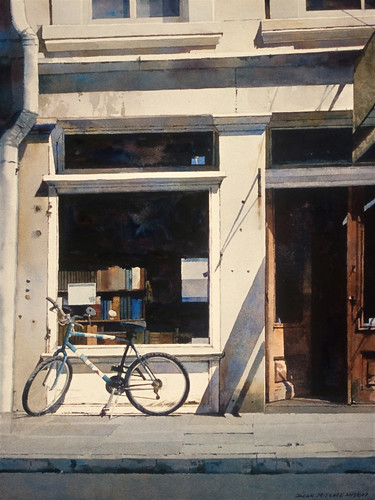
[Watercolour, 20 x 15 inches]
Sunday, August 15, 2010
Saturday, August 14, 2010
Hendrick Goltzius - The Fall of Man [1608]

The cat at Eve's feet is a symbol of the devil who awaits the sinner's soul in order to ruin it forever. The snake who occupies the place of a halo over Eve's head recalls the snake who first tempted Eve in the Garden of Eden, offering her an apple from the Tree of Knowledge, and thus also symbolises the devil. Olives like those in Eve's hand are a symbol of the Eucharist, the future redemption of sins. The dog at Adam's feet and the whole walnut in his hand are symbols of virtue which resists temptation. The tulip which has blossomed between Adam and Eve has an ambiguous reading, for it could be both the brief joys which Adam and Eve will find in the world into which they are being cast, or hope of salvation. We should see a world of purity and plenty in the far of landscape with its bluish haze in the air.
[Oil on panel, 203 x 134 cm]
Friday, August 13, 2010
Louis Gabriel Eugene Isabey - After a Storm [1869]
Thursday, August 12, 2010
Alphonse Mucha - The Times of the Day [1899]
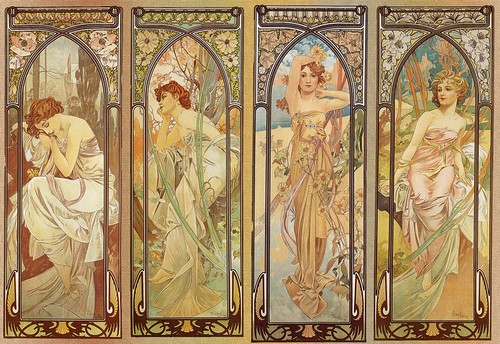
Like every aspiring artist of the day, Mucha ended up in Paris in 1887. He was a little older than many of his fellows, but he had come further in both distance and time. A chance encounter in Moravia had provided him with a patron who was willing to fund his studies. After two years in Munich and some time devoted to painting murals for his patron, he was sent off to Paris where he studied at the Academie Julian. After two years the supporting funds were discontinued and Alphonse Mucha was set adrift in a Paris that he would soon transform. At the time, however, he was a 27 year old with no money and no prospects - the proverbial starving artist.
Paul Gauguin - Sacred Spring Sweet Dreams [1894]
The Tahitian girls symbolise different stages in life. The young islander with the halo above her head, deep in sleep, is the embodiment of virgin purity, while the second girl with the fruit in her hand, ready to take a bite, is like Eve. In the depths of the landscape islanders are dancing around an idol, some mysterious ancient god. The canvas reveals the artist's very individual style with its pure colours applied in generalised flat areas which, like the lines, are subjugated to a single rhythm.
[Oil on canvas, 74 x 100 cm]
Wednesday, August 11, 2010
Tuesday, August 10, 2010
Nikolai Blokhin - Patricia and Margo from the Taos Tribe [2008]

[Oil on canvas, 130 x 130 cm]
Monday, August 9, 2010
Marie Laurencin - Bacchante [1911]

[Oil on canvas pasted on cardboard, 32.7 x 41 cm]
Sunday, August 8, 2010
Unknown Artist - The Last Supper
Edouard Dantan - A Casting From Life [1887]

Saturday, August 7, 2010
Theodore Bernard de Heuvel - After the Unsealing of the Will [1869]

[Oil on canvas, 88.5 x 115 cm]
Friday, August 6, 2010
Ivan G. Olinsky - Serviceman's Wife [c.1942]
[Oil on canvas, 91.4 x 76.5 cm]
Thursday, August 5, 2010
Wednesday, August 4, 2010
Franz Kruger - Portrait of Count Alexander Kushelev-Bezborodko [1850-51]

Tuesday, August 3, 2010
Charles Guilloux - The Flood [1893]
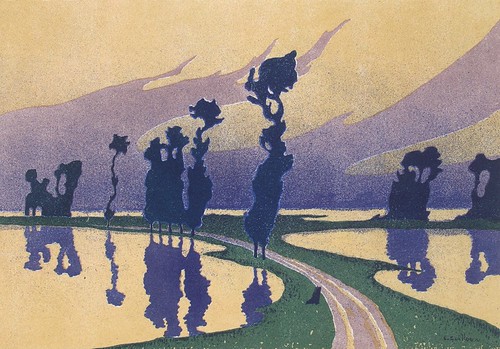
[Colour lithograph, 20.7 x 29 cm]
Monday, August 2, 2010
Louis Ritman - The Open Window






